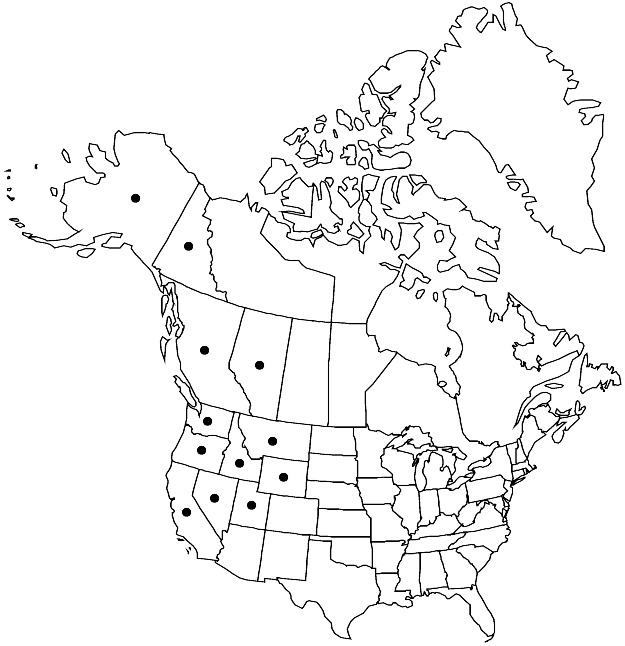Arabis eschscholtziana
in C. F. von Ledebour, Fl. Altaica 3: 25. 1831.
Biennials or perennials; (caudex branched); usually densely hirsute (at least basally), trichomes simple or stalked, forked, sometimes glabrescent with mostly simple ones. Stems simple or several from base (rosette), erect, often branched distally, 2–7 (–10) dm, (hirsute basally, trichomes simple and minutely stalked, forked, rarely almost exclusively glabrous). Basal leaves: petiole 0.7–3 cm, (ciliate or not); blade broadly spatulate to narrowly oblanceolate, 1.2–10 cm × 7–30 mm, margins entire or dentate, apex obtuse or acute, surfaces usually pubescent, sometimes glabrous, trichomes simple, forked and stalked, stellate. Cauline leaves (2–) 4–12 (–18), (well-spaced or, rarely, overlapping); blade ovate to oblong or lanceolate, 1.5–6.5 (–10) cm × 5–30 mm, base auriculate, margins dentate or entire, apex acute or obtuse, surfaces sparsely hirsute or glabrous. Racemes simple or branched. Fruiting pedicels erect to erect-ascending, 3.5–10 (–15) mm, (glabrous or sparsely pubescent). Flowers: sepals oblong, 3.5–5 × 1.2–2 mm, lateral pair saccate basally; petals white, rarely pink, linear-oblanceolate or narrowly spatulate, (5.5–) 6.5–9 (–10) × 1.5–3 mm, apex obtuse; filaments 3.5–6 mm; anthers oblong, 0.7–1 mm. Fruits erect to erect-ascending, (often appressed to rachis), torulose, 3.5–6.5 cm × 1.2–1.8 (–2) mm; valves each with prominent midvein extending full length or to middle; ovules 54–80 per ovary; style (0.1–) 0.3–1 mm. Seeds usually narrowly winged throughout or only distally, rarely not winged, oblong or suborbicular, 1–1.8 × 0.9–1.3 mm; wing to 0.2 mm wide distally. 2n = 32, 64.
Phenology: Flowering (Apr-)May–Jul.
Habitat: Rocky slopes, crevices, and ledges, meadows, moist banks and grounds, granitic soil, wooded slopes
Elevation: 0-2800 m
Distribution

Alta., B.C., Yukon, Alaska, Calif., Idaho, Mont., Nev., Oreg., Utah, Wash., Wyo.
Discussion
G. A. Mulligan (1996) recognized Arabis eschscholtziana as a distinct species; R. C. Rollins (1941, 1993) treated it as a variety of A. hirsuta. As discussed under A. pycnocarpa, A. hirsuta does not occur in North America, and the characters separating all three species (see key to species), as well as the different ploidy levels, support Mulligan’s conclusion.
Both M. Hopkins (1937) and R. C. Rollins (1941, 1993) recognized the glabrous or subglabrate forms native to North America as a distinct variety, var. glabrata; G. A. Mulligan (1996) did not accord such forms any taxonomic status. Glabrous and subglabrate forms occur in both Arabis eschscholtziana and A. pycnocarpa and sometimes even within a population that has moderately to densely pubescent forms. I support Mulligan’s view in not recognizing the glabrous forms as an infraspecific taxon.
Selected References
None.
Lower Taxa
"elongated" is not a number."thick" is not a number."dm" is not declared as a valid unit of measurement for this property."dm" is not declared as a valid unit of measurement for this property.